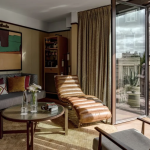Located at 1 North Beisen Road, the site covers an entire block who measures 237 metres from east to west and 178 metres from north to south. It sits in middle of mature communities and is surrounded by streets. The land use of the site is for community sports. Originally there were a golf course and a natatorium – which has been preserved and rehabilitated later as a multi-function centre. A plot ratio of 2.0 is allowed, with 40 percent coverage and the maximum height of 24 metres.

The project aims to integrate a variety of social resources combing sports and leisure activities, cultural and artistic events, and fashion and creative industries into one a local collective-living space. The project expects to fulfil various practical needs and continuously vitalize urban communities.
Following the architectural philosophy of “contemporary approach with historical ethos”, the design refers to the space prototypes of collective-living compounds during the planned economic era (1950s-1980s); and it attempts to transfer such community space with a flavour of idealistic collectivism into the current architectural language. The project synthesises collective memory, vernacular characteristics and modern lifestyle in order to provide a contemporary arena for diversified lifestyles in modern cities.
Using functionality, cost-efficiency, practicability and honesty of material etc as a starting point, the design intentionally reveals the underlying nature of the construction and produces a distinct morphological aesthetics – essential functions/structures give the building forms.
To makes the best use of the current situation – an entire block with specific height limit and surrounded by high-rise buildings, the design employs low-rise buildings as a focal point for the high-rise residential communities and wide horizontal span as a dimensional advantage. The project encircles the entire block along the periphery – 182 meters from east to west and 137 meters from north to south – to maximize the inner area of sports and green as well as optimize visitors flow rate along the streets. Different from accustomed concentrated complexes, the enclosed courtyard becomes an green basin open for public and continue to carry on a traditional Chengdu lifestyle – self-sufficient yet open to the outside world. Meanwhile, the project tries to explore the interrelation between modern urban development, new business model and local culture, from a perspective of architecture.

The building has two full stories underground, and five to six stories aboveground; it encloses continuously at the east, south and west sides to the maximum extent. The enclosing layout with a sequence of wide horizontal floors and eaves forms a powerful aura field and distinct the project from the surrounding urban environment. The four bridge-gallery entrances on the ground floor and the colonnade of elevated track on the north connect the internal and the external and makes the courtyard an enclosing yet open site.
The street facade has an open cantilevered exterior corridor so that every shop can face the street in independent way. The outreached veranda strengthens the horizontal direction and forms a clear public space; while the interface between indoors and outdoors set back behind the orderly columns and uses aluminium frame high-permeable glass. It is simple, common and functional without any special designs in order to allow potential individual decoration and presentation and eventually develop a much more diversified facade display.
The internal facade has continuous balconies that allows all users can share the inner court view. In the courtyard, its line of sight is from the periphery to the centre that similar to the structure of Coliseum. Wide bar table-styled balcony handrails are made of high-resistance reconsolidated bamboo can be used as desk for reading or working while enjoying the courtyard view. Removable partition walls can be placed at every bay width. Therefore it can be adjusted flexibly according to different circumstance. Nevertheless, the heterogeneous shop decoration will be included into the order of the large compound, and consequently generates a rich but homogenous marketplace facade.
Without setting standard floors, the design employs varied floor heights to meet different functional requirements. It also adapts the “Honeycomb-core hollow dense-rib floor system” in order to create wide open space with higher storey height to meet flexible and various needs. To highlight the importance of the entrance, such system is used without internal mould and exposes the intersecting parallels-shaped bottom surface of the dense-rib beams. It aims to produce effects similar to the traditional caissons ceiling via basic construction method.
The application of locally-handmade bamboo pallet as template delivers a unique texture on the surface of concrete, which also abstractly refers to the local vegetation. The project conveys a strong vernacular sense by fine horizontal parapets with bamboo pallet texture, classic octagonal columns and the far-reaching eaves with semi-sectional bamboo texture.
The drainage system uses black iron cast downpipes and Y-shaped arrangement connecting two rainwater collections in the shortest distance. The unconventional Y-shaped drainage system is economical and efficient and also turns the usually hidden functional components into a unique and artistic presentational elements.
The construction joints are exaggerated and become an artificial landscape of “a thread of sky”. Besides, it resolves the problem of concealing equipment room and air ventilation. It tries to exhibit “physiological faults” during the process of the construction. Likewise, the extracted reinforcing bar out of concrete at the side corridor are used as parapets and handrails.



